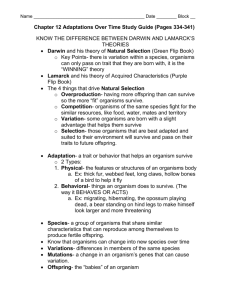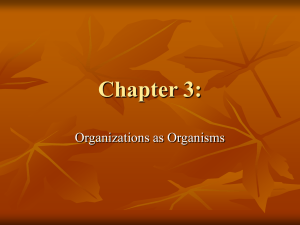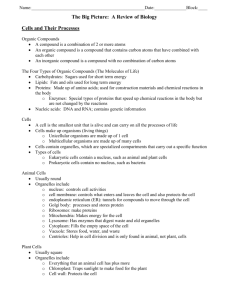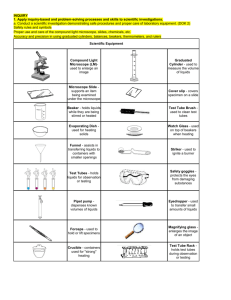Lizzy Adamson`s Organism Essay
advertisement
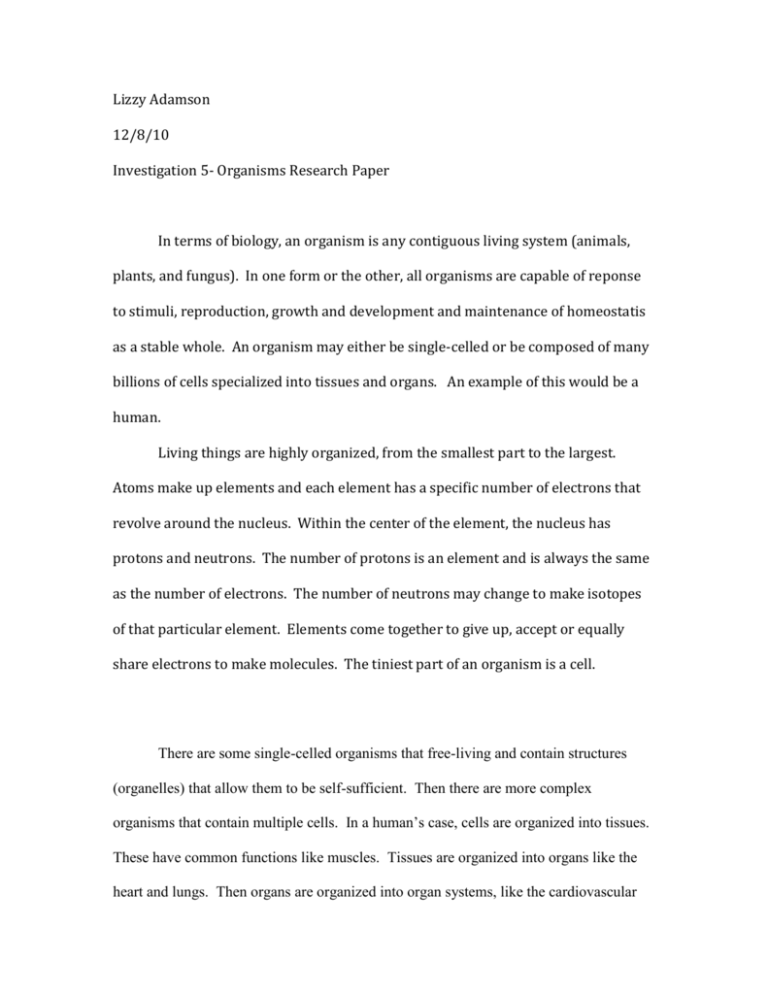
Lizzy Adamson 12/8/10 Investigation 5- Organisms Research Paper In terms of biology, an organism is any contiguous living system (animals, plants, and fungus). In one form or the other, all organisms are capable of reponse to stimuli, reproduction, growth and development and maintenance of homeostatis as a stable whole. An organism may either be single-celled or be composed of many billions of cells specialized into tissues and organs. An example of this would be a human. Living things are highly organized, from the smallest part to the largest. Atoms make up elements and each element has a specific number of electrons that revolve around the nucleus. Within the center of the element, the nucleus has protons and neutrons. The number of protons is an element and is always the same as the number of electrons. The number of neutrons may change to make isotopes of that particular element. Elements come together to give up, accept or equally share electrons to make molecules. The tiniest part of an organism is a cell. There are some single-celled organisms that free-living and contain structures (organelles) that allow them to be self-sufficient. Then there are more complex organisms that contain multiple cells. In a human’s case, cells are organized into tissues. These have common functions like muscles. Tissues are organized into organs like the heart and lungs. Then organs are organized into organ systems, like the cardiovascular system or the circulatory system. Organ systems functioning together are what create a living organism. A population is an organism of more than one individual. This is basically all of one species in a particular area. An example would be all the deer that live in Yellow Stone National Park. If one expands their view, the next would come a community. An example of a community is the town or city where people live. A biological description would include all the living things within that area. A community is made up of many species, including plants and animals. An ecosystem doesn’t only consider the living things in its area, but also the physical environment and the interrelated flow of energy. A good example of this is a coral reef. Corals are a vital part of the Earth’s ecosystem. They host more than 25% of the world’s ocean fish species and about 11% of ocean species in general, such as sharks and some types of dolphin. However, at the rate that ozone depletion is going, 70% of the world’s reefs will be gone. Already, 30% are irreparably damaged. 2. All living things have an ability to acquire materials and energy. Most of us call this eating! Then we have to be able to convert our food, a form of energy, to chemicals our cells can use through metabolism. Some organisms like plants, algae, and some microorganisms are autotrophs. The autotrophs we are most familiar with are the green plants that use photosynthesis to make their own "food." Some bacteria use chemosynthesis for their energy source. Animals and fungi are heterotrophs and capture their food in a variety of ways. The ability to acquire and use energy is extremely important. Without a constant input of usable energy, organisms would quickly become "disorganized" and die. In order to survive, organisms must be able to achieve homeostasis. Each type of organism has a specialized way to stay in balance with its outside and inside environments. A paramecium has a contractile vacuole that pumps excess water out of its cell in order to survive in a fresh water environment. You and I have an internal "thermostat" that helps us maintain a body temperature of about 98.6 degrees Fahrenheit. 3. All living things have an ability to respond to their environment. This often results in movement of the individual toward safety. This helps to ensure survival of the organism. For example, as young children we learned to avoid hot stoves and busy streets. Plants also have some limited ability to move. They grow up toward the sun, and some have leaves able to turn to follow the sun, allowing them to photosynthesize better. Their roots grow down to search for water and minerals. If a plant doesn't get enough sunlight, water or minerals it will die. 4. All living things have an ability to reproduce. All living things, even the smallest bacteria, have a chromosome containing DNA. Prokaryotes like bacteria only have one circular chromosome, called a plasmid. Eukaryotes, multicellular organisms like plants and humans, have a species-specific number of chromosomes. As humans, we have 46 chromosomes, in 23 pairs. Genes on chromosomes contain the instructions for the organism's structure and function. However, the amazing diversity of organisms on earth have resulted because most organisms reproduce sexually. Some, like earthworms are hermaphrodites. Most others have separate sexes, male and female, like marijuana plants, fish, birds, cattle and humans. In order for two organisms to combine their genetic information without doubling the number of chromosomes given to offspring, Mother Nature came up with a way to reduce the number of chromosomes. Without it, each new generation would have double the number of its parents' chromosomes. This halving is done by meiosis in the sex organs. In the female, the ovary produces haploid eggs and in the male the testes produces haploid sperm. Each of these gametes contains only one chromosome from each of the pairs of chromosomes. During fertilization, the sperm and egg unite to form a zygote, a diploid individual. This new individual is different from either parent, although it contains characteristics from both. This is what gives us the great diversity of life. In living things, we call this genetic biodiversity. 5. All living things have an ability to adapt. Modifications enable an organism to survive in its environment. Natural selection allows individuals with better adaptations to survive better and reproduce more. Thus, their characteristics are passed into future generations and that makes the species stronger. However, it is important to note that individuals can only adapt to their environment, and species don’t adapt, they evolve. All living things: 1. Are comprised of one or more units called cells 2. Reproduce (sexually or asexually) 3. Grow and develop 4. Obtain and use energy 5. Respond to their environment 1) All living things are comprised of cells.







